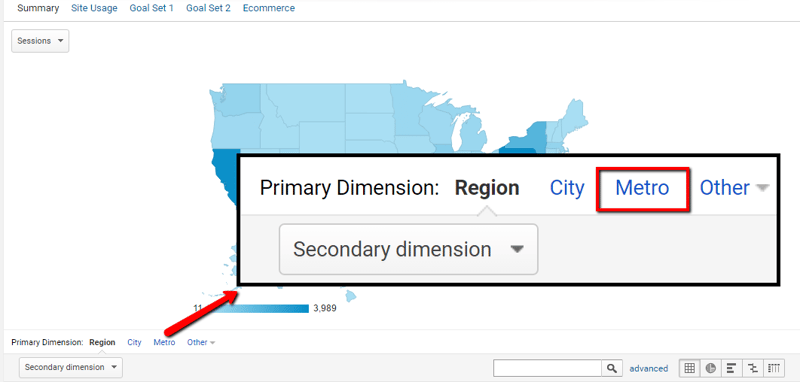Enhance Your Data Analysis Using Secondary Measurement in Google Analytics
Exploring the capabilities of second dimensions in Google Analytics opens up a world of opportunities for refining data analysis. The ability to dissect info further beyond the surface degree presents a nuanced view that can shape tactical decisions. By layering added measurements onto primary information sets, an even more elaborate narrative emerges, dropping light on user interactions and efficiency indications. This vibrant technique to data examination holds the crucial to unlocking hidden patterns and fads that might transform exactly how organizations analyze their digital impact.
Comprehending Additional Dimensions
Second measurements in Google Analytics refer to extra specifications that can be added to the main measurement, allowing for an extra thorough evaluation of information (Secondary Dimension in Google Analytics). By integrating additional measurements, experts can section and filter information to uncover patterns, patterns, and correlations that may not be evident when looking at the information as a whole.

Advantages of Utilizing Secondary Measurements
When evaluating information in Google Analytics, the use of secondary measurements uses important insights right into user actions and performance metrics. By including an additional dimension to your primary data, you can dive deeper right into the qualities of your website site visitors and their interactions.
In addition, additional measurements improve the context of your primary data, providing an extra thorough sight of customer engagement and performance metrics. In general, the use of secondary measurements in Google Analytics can substantially enhance the deepness and quality of your information analysis, leading to even more informed decision-making and improved end results.
How to Add Second Dimensions
By incorporating secondary measurements in Google Analytics, customers can acquire much deeper understandings right into their data evaluation process, permitting for even more detailed assessment of user behavior and efficiency metrics. Adding additional dimensions is an uncomplicated procedure that can significantly enhance the deepness of analysis. When in the report, find the "Secondary dimension" tab above the information table.
Studying Data With Second Measurements
Making use of additional dimensions in data evaluation offers a much more extensive understanding of customer habits and performance metrics. By adding a secondary dimension to your primary data embeded in Google Analytics, you can delve much deeper right into the characteristics of your site site visitors and their communications. For instance, incorporating the key dimension of 'source/medium' with the second dimension of 'touchdown web page' can expose which details web pages are attracting website traffic from different sources, aiding you enhance these web pages for far better involvement.

Essentially, evaluating information with secondary measurements encourages you to gain beneficial understandings into customer actions, identify trends, and make informed decisions to enhance the efficiency of your digital homes.
Ideal Practices for Second Dimensions
In information analysis, including second dimensions successfully can considerably improve the deepness of insights originated from metrics and user habits patterns. When using additional dimensions in Google Analytics or any type of various other logical device, it is important to adhere to best techniques to ensure the accuracy and relevance of the data evaluation.
One secret ideal method is to carefully pick additional measurements that complement the main dimension being evaluated. Selecting additional measurements that offer added context or additional division can use a much more comprehensive understanding of the information. It is also vital to prevent overcomplicating the analysis by including also many second measurements, which may lead to confusion or dilution of understandings.
Moreover, it is a good idea to trying out different combinations of primary and secondary dimensions to uncover brand-new connections and fads. Consistently evaluating and improving the choice of secondary measurements based upon the particular goals of the evaluation can result in more workable understandings. By complying with these best practices, data analysts can leverage second dimensions successfully to improve the total data analysis process and decision-making capabilities.

Verdict
To conclude, integrating additional dimensions in Google Analytics is vital for a thorough data evaluation approach. By leveraging secondary measurements along with key ones, experts and online marketers can uncover beneficial insights and connections that can inform decision-making and optimize electronic advertising and marketing methods. Understanding just how to efficiently make use of secondary dimensions and following ideal techniques will permit experts to draw out significant data and boost their general efficiency metrics.
Secondary dimensions in visite site Google Analytics refer to added specifications that can be included to the key measurement, enabling for a more detailed analysis of data. By incorporating secondary dimensions, experts can section and filter data to reveal patterns, patterns, and relationships that visit our website could not be apparent when looking at the information as a whole. Combining the primary measurement of 'source/medium' with the second measurement of 'landing web page' can expose which specific pages are bring in website traffic from different sources, helping you enhance these pages for better engagement.
One secret finest method is to carefully pick second measurements that match the main dimension being analyzed. By complying with these finest techniques, data analysts can utilize second measurements properly to boost the general data analysis procedure and decision-making capabilities.